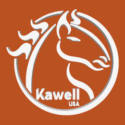The glue–on shoe is another tool in your toolbox. As the farrier, you need to make the conscious decisions on when you’ll use it and how you will modify the shoe.
Travis Burns http://www.vetmed.vt.edu/people/bios/burns-travis.asp, lecturer and chief of farrier services at Virginia-Maryland College of Veterinary Medicine, provided this thought during a hands-on workshop during the American Farrier’s Association Annual Convention in Mobile, Ala. Soundhorse Technologies provided all of the materials for this session. Here are his tips for improved success when gluing on cuffed shoes.
Preparation is everything. As he began his demonstration of gluing on a shoe, Travis Burns noted that the focus was only on application. Because he and the attendees would be applying the shoes to balanced urethane feet, no preparation was required.
“Prep work will make or break your success with glue,” he says. “You don’t want to glue to a wet foot, or to a foot with dirt and debris on it. You want to have the foot as clean as possible and do this in a clean, dry environment. Don’t think you can just walk up to a foot and glue a shoe on.
Time is critical. Lay out everything you need for the complete process before you mix the glue. Make sure the horse is prepared and is going to stand well for the application.
“Once you get glue on the cuff it has to go on the foot,“ he says. “You can’t clean it and re-glue it. You want a nice seamless process.”
Before you mix the glue, you need to have determined whether a horse will stand for you to do the work. Sedation may be required to improve the likelihood.
“Be honest with yourself and the client,” he says. “There is no sense in wasting this if the horse simply isn’t behaving.”
He advises explaining the difficulty and expense in the application, including things that may upset the horse like the noise created by wrapping the foot, so they better understand the decision.
Protect yourself and the horse. It’s likely you will have glue on your gloved hands during the process. Apply leg wrap beforehand to the hoof and limb.
 FIGURE 1
FIGURE 1
“I like to start at the bottom and cover the limb at least to the mid cannon,” he says. “Then roll it up to the coronary band and cover that with electrical tape or any tape that the glue can’t penetrate.” (Figure 1)
Understand the glue. For the application of a SoundHorse Technologies Series 1 shoe , poly-methyl methacrylate adhesive (EquAcrylic™ Adhesive, Equilox, Grand Circuit Pro-glue, Equi-bond, etc.) must be used. For mixing the glue provided in the Soundhorse kit, Burns prefers pushing the resin into the accelerator area of the joint bag.
For his personal preference, Burns further mixes the glue in a plastic cup with a tongue depressor for a uniform mixture. He finds stirring the glue this way will give a good feel for the correct time to apply.
“Stir the glue for at least 1 min then apply to the cuff and the hoof. Once it starts to feel tacky apply the shoe to the hoof.” he says. “It will feel tacky. You don’t want to apply the shoe to the hoof when the adhesive is still thin and runny.
Depending on where you are, the temperature will affect the speed at which the glue sets up.
Mind the heat. When grinding an aluminum shoe attached to the cuff, mind the heat, otherwise the bond between cuff and shoe could be weakened.
 FIGURE 2
FIGURE 2
Prep the cuff. After you shape and prepare the shoe for the foot, take scissors to remove excess cuff in the heel area. (Figure 2)
“You don’t want the cuff on the heel bulbs,” he says. “You can remove portions of the cuff if you don’t want to cover areas of the hoof that may be diseased or deteriorated. ”
Applying glue to the cuff. Spread the glue on the exterior and interior layers of the cuff as uniform as possible, covering the entire cuff.
Applying the cuff to the foot. Press the cuff as flat as you can, removing all wrinkles. The glued cuff should be able to hold itself without moving.
Wrapping the foot can prove to be difficult. Burns recommends going from the widest part of the foot, across the toe, onto the other widest part of the foot. Otherwise you may shift the shoes. Four or five passes should be enough. Then wrap straight up and over the heels of the shoe with at least 10 turns, then cover all areas of the cuff.
Use your hoof knife or the tape tube to smooth out the wrap. This presses out excess glue between the layers of the cuff and makes a smoother appearance.
Burns stresses you need to know your horse. If a horse places a foot down, loads and twists, you will want to keep the foot elevated for a few more seconds to allow the glue to set and use more wrap.







